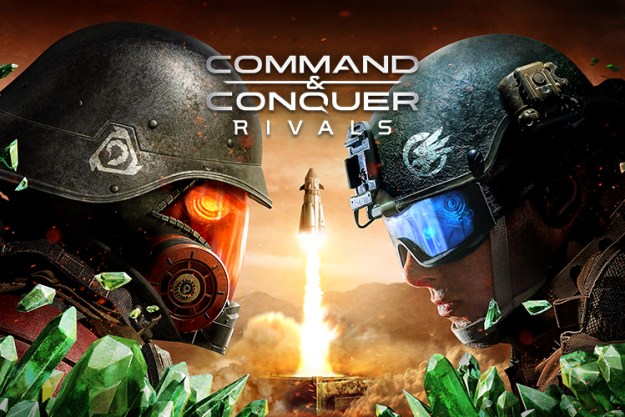
“Fast matches and easy-to-learn gameplay make "Command & Conquer: Rivals" great for quick competition.”
- Super-quick matches
- Control point focus makes for interesting battles
- Short learning curve
- Maintains the spirit of bigger RTS games
- Competition can get suitably intense
- It's not really "Command & Conquer"
- Fairly thin, casual experience
- Not clear if it's deep enough for long-term engagement
Fans have been hoping for a new Command & Conquer for years now, and publisher Electronic Arts keeps teasing them. First, EA announced and cancelled its 2013 free-to-play reboot, simply called Command & Conquer. Now, at EA Play 2018, it announced Command & Conquer: Rivals, adaptation of the real-time strategy franchise. This is definitely not the robust military strategy game die-hard fans were looking for, but Rivals is a solid little mobile game that’s easy to learn and play, fun to compete in, and just deep enough to scratch the same RTS itch that would usually require one of its grown-up cousins to satisfy.
Command & Conquer: Rivals presents players with super-fast matches — great for a quick gameplay infusion without a big time commitment or learning curve. EA’s Redwood Studios has done a good job of translating the spirit of the Real-time strategy game, which is generally a very involved experience with complex controls, to a light mobile game experience that still evokes tension and makes you work for each victory.
Rivals pits two players against each other in a scaled-back version of classic RTS gameplay. When matches start, both players have a base nestled on one side of the screen, with the other player’s base just on the other side. The idea is to destroy the opposing base, but doing that isn’t about raising a big army and laying siege to its buildings, as you would traditional RTS games. Instead, players compete to capture three strategic points on the map, which prepare a nuclear missile in the center of the screen. When one person controls the majority of those areas, a meter fills, arming the missile. When one player fills the meter completely, the missile fires at their opponent’s base, draining half of its health.

Most of the standard rules of RTS games are still in play in Rivals. You start the match by sending a resource collection unit to mine a mineral called Tiberium, which you then spend on units like soldiers, tanks, mechs and planes. Investing in different add-ons for your base diversifies the types of units you can purchase. Portraits of units you can purchase span the bottom of your screen, and tapping one deploys it instantly. Once deployed, you can tap each unit to select it, and tap the map where you want the unit to go, or tap an enemy that you want it to attack. Otherwise, it’ll attack enemies automatically when they come into range.
Get your game on
- Best gaming laptops
- Best gaming desktops
- Best gaming headsets
- Best gaming mice
- Best gaming keyboards
- Best gaming monitors
You need to direct units to stand on the control points around the map to take over the missile, but if both players have units on a control point, it stays neutral. That means that each match quickly becomes about contesting control points by outthinking your opponent as quickly as you can. If they send soldiers, you send flamethrowers that can overpower those soldiers. If they send tanks, you send aerial units the tans can’t hit. Most of the strategy is in picking the right unit for the job, while placing your troops on the map to cut off pathways that would allow your opponent to reinforce their positions.
The trick is to strike at the right moment, because winning is not necessarily about having the strongest army at the end of the match. Controlling the majority of the points on the map can flip the missile from one player’s control to the other’s, but the arming meter keeps filling no matter who is control. If you’re smart and quick, you can swoop in at the last moment as the missile arms, take control, and strike your enemy’s base. It takes two missile strikes to win a match, though, so you can’t win off pure luck.
All those strategic elements interact with an easy user interface to make a game that may not have the depth or complexity of a larger PC or console RTS game, but gets close enough to it to support strategic thinking. All you really need to know to succeed in Rivals is which of the 8-10 units can overpower the others. It’s easy to learn, and you don’t have to get bogged down in the nitty gritty of how the game works to compete — you just have to be good at the intuitive part of cutting off your opponents’ plans.
You don’t need to play or practice like a pro to enjoy Rivals.
All this happens inside of five minutes, so even if you and your army get stomped, it really doesn’t matter. That’s what makes Rivals such a solid mobile experience: The investment of time on the player’s part is small, but the game still feels deep, fast-paced and intelligent. It’s a mini version of a more involved strategy game, one that’s great for killing a couple of minutes, or for getting very competitive.
While EA initially showed Rivals in a way meant to evoke esports-style competitive play, complete with two professional gamers and a professional shoutcaster calling the match, it seems like a stretch to think Rivals‘ quick matches will bring in that kind of community. While there seems to be enough depth to encourage players to get pretty good at the game, but that vision of the game ignores the game’s greatest strength. You don’t need to play or practice like a pro to enjoy Rivals. It’s great for battling a friend or a stranger for a couple of intense minutes and then signing off. It may not the Command & Conquer revival fans might have hoped for, but Rivals is some lightweight fun that seems like it’ll be worth installing on your phone for when the lust for battle strikes.


